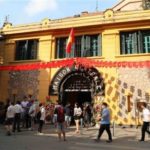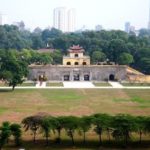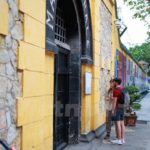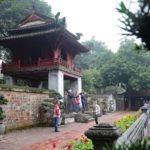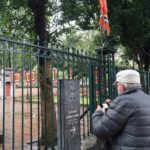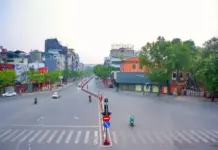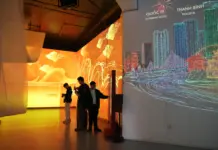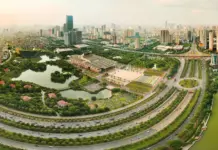With abundant cultural resources, Hanoi’s heritage destinations have been constantly developing impressive and distinctive cultural products from their unique materials.
| The poster of the night tour titled Sacred Night 3 – The Flame of Youth at Hoa Lo Prison Relic. |
This not only helps promote these destinations but also contributes to unleashing creativity from heritage resources, which is the goal set by the Hanoi Party Committee’s Resolution on “Developing the cultural industry in the capital in the period 2021-2025, with an orientation towards 2030 and a vision for 2045”.
Creativity from unique materials
Some museums and monuments in the capital city have been renovated in recent years and attractive tours have been designed to meet the preferences of tourists of all ages. Which, Hoa Lo Prison Relic is a typical example.
After the enormous success of the series of experiential activities, including the night tours ‘Sacred Night – Shining Vietnamese Spirit’ and ‘Sacred Night 2 – Living Like Flowers’, Hoa Lo Prison Relic’s Management Board has recently introduced a new cultural product entitled ‘Sacred Night 3 – The Flame of Youth’, honoring young heroes by telling historical stories at Hoa Lo Prison Relic.
In particular, the re-enacted scenes have been augmented to give viewers a better understanding of the harsh life in “a hell on earth”, as well as the seething fighting spirit of the revolutionaries.
| A scene from the night tour Sacred Night 3 – The Flame of Youth at Hoa Lo Prison Relic. Photo courtesy of the tourist site |
Notable scenes include martyr Nguyen Hoang Ton proudly accepting death by the guillotine in the prison yard in 1931, the hunger strike in 1933, the “Turning Prisons into Revolutionary Schools” movement, the escape in 1945, and the last meeting between comrade Nguyen Duc Canh and his mother.
As the narrator of the latest experiential activity, La Thi Thuy from the Communication Division of Hoa Lo Prison Relic said that the scenes are realistically staged, highlighting the images of the country’s faithful heroes.
Notably, visitors can play the role of political prisoners, experiencing the dark and stuffy cells or the hardships and dangers of escaping through the underground sewers. Through this experience, they can feel more deeply the spirit of overcoming hardships and the persistent youthful flame in the prison.
Earlier, the opening ceremony of the exhibition themed “Van Mieu in the Revival of Hanoi’s Heritage” was held at the relic site of the Temple of Literature, recounting the process of heritage restoration – from a desolate “Crow Pagoda” in the past to the majestic temple as it is today.
With many rare documents arranged as a journey back in time, the exhibition also highlights the tireless efforts and determination of the participants in identifying, restoring, and preserving the heritage from the strong impact of time.
According to Le Xuan Kieu, Director of the Van Mieu – Quoc Tu Giam Center for Cultural and Scientific Activities, the exhibition is one of many cultural activities aimed at promoting the value of relics, enhancing the attractiveness of heritage destinations, and meeting the sightseeing and research needs of domestic and foreign tourists.
| Foreign visitors to Temple of Literature in Hanoi. Photo courtesy of the tourist attraction |
Boosting the development of cultural tourism
Along with the Hoa Lo Prison Relic and the Temple of Literature, many museums and relics throughout Hanoi have promoted the creation of new cultural products in order to enhance the attractiveness of the places.
A typical example is the heritage site of Thang Long Imperial Citadel, with the experiential tour “Royal Palace Night” following the “Deciphering the Thang Long Imperial Citadel” tour, which debuted in 2021.
Similarly, the Relic Management Board of Duong Lam Ancient Village has offered a series of heritage experiences named “Ancient Citadel – Van Mieu – Va Temple – Duong Lam”, associated with unique stories about the history and culture of Xu Doai or the western and northwestern districts of Hanoi.
Last year, the Hanoi Museum also launched exhibitions on “Old Customs”, “Hanoi – the Land of Hundreds of Trades” and “Hanoi 1972 – Aspiration for Peace” drawing on the diverse documents and artifacts in its storehouse.
Although they are all inspired by heritage resources, each of the cultural products is born with its own impressive identity that draws visitors to the site.
| The “Royal Palace Night” tour to Thang Long Imperial Citadel has attracted visitors nationally and internationally. Photo: Thang Long- Hanoi Heritage Conservation Center |
According to Nguyen Huu Dung, a tourist from Quan Hoa Ward, Cau Giay District, the exhibits at Hanoi Museum really create cultural products with depth and bold identity for today’s life.
As for Nguyen Bich Ngoc from Ton Duc Thang Street, Dong Da District, she was very touched by historical stories at Hoa Lo Prison Relic: “This is a vivid and fascinating approach to heritage for many age groups, not just a specific group of people”.
Concerning the effectiveness of fostering heritage values at museums and monuments recently, Nguyen Viet Chuc – Director of the Thang Long Institute for Cultural Research – said that cultural heritage is a valuable asset that, if properly preserved and utilized, can not only preserve the priceless values inherited from our forefathers, but also become a leading sector and a driving force for socio-economic development.
“It is necessary that Hanoi train a culture-savvy staff, plan long-term programs, develop products with depth and identity and ensure the goal of sustainably promoting and honoring heritages,” he said.
In this regard, Do Dinh Hong, Director of Hanoi’s Department of Culture and Sports said that the city is pursuing cultural industry development goals.
Currently, the capital’s cultural sector is actively directing relevant units to focus on making experiential activities and exhibitions more creative, in a more appealing and professional manner, thereby effectively promoting heritage values, increasing the attractiveness of destinations, and step-by-step boosting cultural tourism in the capital.
| A foreign visitor to Duong Lam ancient village in Hanoi. Photo: Huy Pham |
Press’s role in tangible cultural heritage preservation highlighted
NDO/VNA – Researchers, scientists, managers and journalists stressed the press’s role in preserving and upholding tangible cultural heritages in Hanoi at a workshop on June 11.






